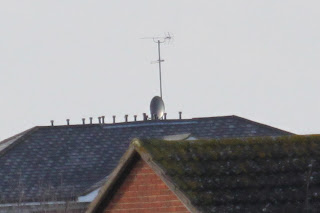Is it worth buying an SLR, faced with a choice of good bridge cameras?
The latest bridge cameras are small, weigh significantly less than a Digital SLR and deliver excellent image quality, as well as having superb flexibility to suit all types of different photography including birding. So, are there still image quality benefits in investing in a DSLR, given the extra cost and weight?
With this question in mind we thought it would be interesting to compare the image quality of a Canon 500D SLR, to that of a Lumix FZ150 Bridge Camera - which is currently one of the best bridge cameras on the market. It also weighs a fraction of the heavy SLR!
To start the tests, we equipped the Canon 500D body with our semi-professional Canon L 100-400mm lens to observe the differences in image quality (IQ) obtained, when directly compared to the bridge camera. Then, to conclude, we fitted the SLR with the cheap Canon 75-300mm EF telephoto lens to see how the SLR/cheap telephoto lens combo fared on image quality compared to the FZ150 Bridge Camera.
For the tests, the subject we chose was the roof of a building about 3/4 of a mile away. We tried to keep the camera settings similar to make the comparisons more subjective and meaningful. The images were cropped down to 15% of their original size to the centre of the frame, using Photoshop. This represents quite a severe crop - similar to that needed when cropping down pictures of birds taken some distance away. No image processing was carried out.
Test 1 - Canon 500D, Canon 100-400mm L lens
Focal length for test: 350MM x 1.6 Crop factor = 560mm
Sensitivity: ISO400
Shutter Speed: 1/640s
Exposure compensation + 1/3
Aperture: F5.6
Image Stabiliser On
Result: Slightly soft image at F5.6
Focal length for test: 350MM x 1.6 Crop factor = 560mm
Sensitivity: ISO400
Shutter Speed: 1/400s
Exposure compensation + 1/3
Aperture: F8
Image Stabiliser On
Result: Good image with more detail
Lens set to full 24X Zoom (560mm Equivalent)
Sensitivity: ISO100
Shutter Speed 1/125s
Exposure Compensation +0.3 step
Aperture F5.6
Image Stabiliser On
Result: Good image but with more noise evident and some minor chromatic aberration
Comparison Canon 100-400mm L to Canon EF 75-300mm Telephoto Lens
We conclude this series of tests with a comparison of the Canon 75-300mm EF telephoto lens with the much more costly Canon 100-400mm L series 'push-pull' zoom, to determine the benefits of spending more money on a quality L-series Canon lens.Not surprisingly, the results show that the semi-professional Canon 100-400mm F4-F5.6 lens significantly outperforms the cheap Canon EF 75-300mm telephoto lens. For a more subjective comparison both lenses were set 300mm focal length. The IQ difference is especially noticeable 'wide open' at F5.6, where the cheap EF lens performs badly - its images being VERY soft.
Test 4 - Canon 500D, Canon EF 75-300mm lens
Telephoto lens set to 300mm
Sensitivity: ISO400
Shutter Speed 1/1250s
Exposure Bias 0 step
Aperture F5.6
Image stabilisation not supported by lens
Result: This lens is awful at F5.6!
Telephoto lens set to 300mm
Sensitivity: ISO400
Shutter speed 1/320s
Exposure Bias 0 step
Aperture F11
Image stabilisation not supported by lens
Result: Much better at F11, slightly soft
Lens set to 300mm
Sensitivity: ISO400
Shutter speed 1/1250s
Exposure bias 0 step
Aperture F5.6
Image stabilisation on
Result: Far superior image quality
Conclusion
The Panasonic FZ150 bridge camera performed quite well alongside the Canon DSLR, even with the much more expensive 100-400mm L series lens fitted.The only limitations of the Panasonic Lumix bridge camera were picture noise (evident even at low ISO settings) and absolute image resolution, particularly when cropped down. This probably comes down to its sensor being smaller than the APS-C sensor fitted to the Canon 500D. When are they going to fit SLR-sized sensors to bridge cameras?!
Cropped pictures have slightly less detail and appear to be slightly over-sharpened, resulting in hard edges. Slight chromatic aberration is also present in high contrast areas of the crop. This loss of resolution due to noise would result in less feather detail if using the bridge camera for bird photography, especially when the subject is some distance away.
On the plus side, the Lumix FZ150 (with its high quality Leica lens) outperformed the SLR when the 500D was fitted with a cheap Canon EF 75-300mm EF telephoto lens at F5.6. The FZ150 also has a vastly superior image stabiliser to the Canon L lens. Camera shake only became a problem at slow shutter speeds of less than 1/125s even at full zoom.
So, is it still worth buying an DSLR for bird photography? Sure it is, if you want the best image quality and have the money to buy a high quality lens. Digital SLR cameras with their larger sensor sizes tend to suffer less from picture noise. However, it is evident from these tests that an SLR fitted with a cheap telephoto lens can give significantly worst results than a bridge camera!
About the Author
Written by Steve Larkins







No comments:
Post a Comment